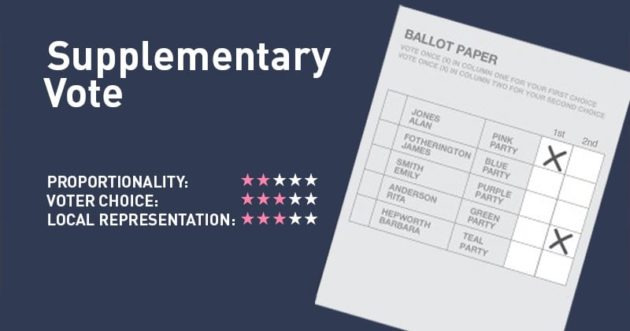A guest post by Graham Sharpe on Kiwiblog on Friday looked at a possible alternative to MMP. While many of us long for the good old days of first past the post, Graham suggests that our choice for change is not a binary situation and that Supplementary Member (SM) should be considered. If, like me, you have no idea what that actually is, Graham helpfully explains that it is something that would avoid the extremes of both MMP and FPP but still give smaller parties a voice.
The benefits of SM apparently are that it would reduce the horse-trading between parties and that there would be no need to “gift” seats, as the threshold for a list seat would be only 2% of the vote.
So how exactly does the supplementary vote work?
The supplementary vote (SV) is an electoral system used to elect a single winner, in which the voter ranks the candidates in order of preference. In an election, if no candidate receives an absolute majority of first preference votes, then all but the two leading candidates are eliminated and there is a second count.
Wiki


We could go to Supplementary Member, as used in Japan and much of Europe. Under this system, parties get electorate seats as they win them. Then they get list seats in proportion to their party vote, but, unlike MMP, the list seats are not combined with the electorate seats to determine the outcome. So if the Banana Party got 10% of the vote they would get 10% of the list seats, so 10% of 49 giving them 5 seats plus any electorate seats. Currently they would get 10% of the 120 total seats, so 12 seats, which includes any electorate seats they already have.
How would the last election have looked had we used SM rather than MMP?
There were 49 list seats.
National got 41 electorate seats and 44% of the List Vote, so would have had 66 seats instead of the 56 under MMP.
So putting the results all together (actual results in brackets):
kiwiblog
National 66 (56)
Labour 48 (46)
NZ 1st 4 (9)
Greens 3 (8)
ACT 1 (1)
TOP 1 (0)
So Labour, plus NZ 1st plus Greens would be 55 (perhaps 56 with TOP joining them). Winston Peters would not hold the power he now does
I think this would lead to better outcomes and governance. Small parties would still be in parliament, and still have a voice. It would also elevate the importance of electorate MPs. The Party vote would not be the more important vote, and List Only parties would suffer, appropriately in my view.
[…] MMP proponents call SM “MMP light”. They are correct. SM would be a better system for NZ. We do not have to go back to FFP.
I would advocate that if we stay with 120 MPs, 80 would be electorate and 40 would be list seats. Any increase in MP numbers would follow a 2/3 electorate and 1/3 list pattern. Recent calls for 150 MPS would result in 100 electorates and 50 list MPs.
I would make a few other changes as well. NZ Citizens only can vote, not permanent residents who are not citizens (anyone on the Electoral Roll at the time of this change could remain on the roll and vote but going forward only NZ Citizens could join the Roll). Voting basically only on the day, not in the couple of weeks leading up to the election (allowing Special Votes for the sick, travellers etc. as in the past)

